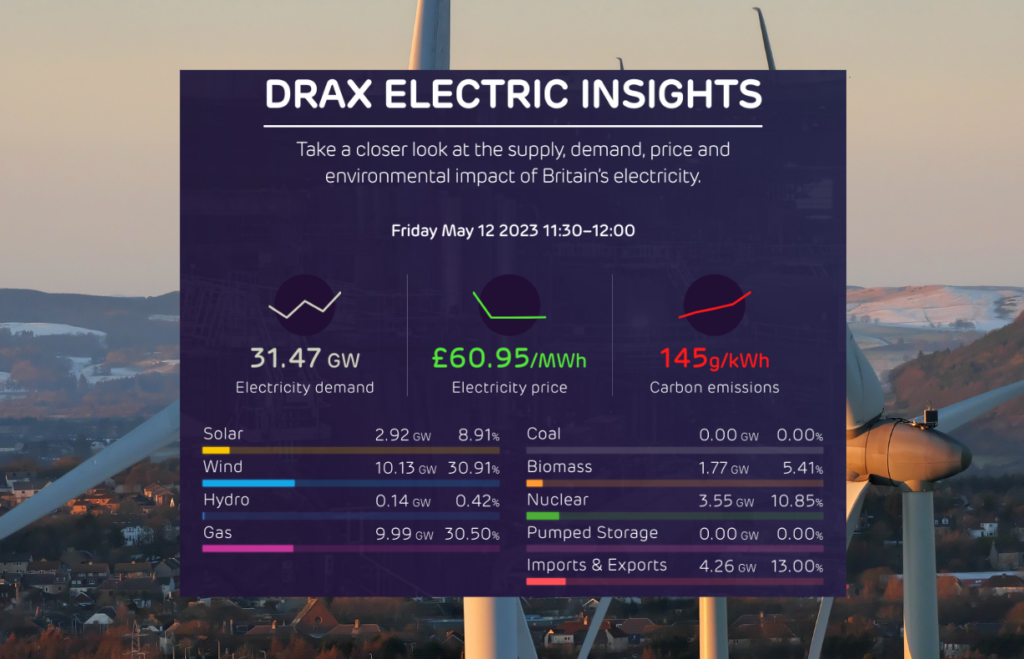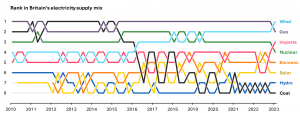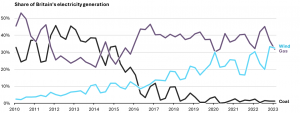Wind Power Becomes UK’s Largest Source of Electricity for First Time

- Britain’s growing fleet of wind turbines generated more electricity than gas-fired power stations for the first time in Q1 of this year
- The country’s turbines generated 24 TWh in three months
- Enough to charge more than 300 million Tesla Model Y vehicles
Almost a third (32.4%) of Britain’s electricity was supplied from wind power during the first quarter of 2023, outpacing gas which delivered 31.7%. It is the first-time wind has provided the largest share of power in any quarter in the history of the country’s electricity grid.
The findings have been released ahead of the next instalment of the quarterly Drax Electric Insights report. The publication is an independent report by academics from Imperial College London commissioned through Imperial Consultants.
Across the three months, Britain’s turbines generated 24 TWh of electricity – enough to charge more than 300 million Tesla Model Ys. Output from wind was 3% higher than during the same quarter last year, while gas was down by 5%.
Almost 42% of Britain’s electricity came from renewable sources (wind, solar, biomass, and hydro) in the first three months of 2023. Fossil fuels supplied 33%, with the rest coming from imports from abroad and the country’s shrinking nuclear fleet.

“The renewable power revolution has transformed how Britain gets its electricity, making our power grid cleaner and greener.
“In the space of a decade the UK has almost completely cut out coal, after relying on the most polluting fossil fuel for over a century to power our country. There are still many hurdles to reaching a completely fossil fuel-free grid, but wind out supplying gas for the first time is a genuine milestone event, and shows what can be achieved when governments create a good environment for investors in clean technology.”
Dr Iain Staffell of Imperial College London, and lead author of the quarterly Drax Electric Insights report series
See related article: Jet2 Announces Major Investment into UK Sustainable Aviation Fuel Production
Britain has just one coal-fired power station left following Drax ending the use of the fuel at its plant in North Yorkshire last month. Once the largest coal-fired power station in Western Europe, the plant is now the single largest generator of renewable power in the UK. Over the last decade four of the power station’s six generating units have been converted to use sustainable biomass, providing the UK with clean, green, and secure renewable electricity.
“This is a remarkable achievement for the UK, and it comes at a vital time when cutting the use of foreign gas is critical to our national energy security. Throughout the energy crisis, biomass has also played a crucial role in providing the country with a reliable source of renewable power to displace fossil fuels from abroad.
“At Drax, we believe the UK must now focus on unlocking investment in carbon negative technologies, such as Bioenergy with Carbon Capture and Storage (BECCS), which permanently remove more carbon dioxide from the atmosphere than they emit. Only BECCS can simultaneously remove millions of tonnes of carbon dioxide from the atmosphere whilst also generating reliable, renewable power when the wind isn’t blowing, or the sun is not shining.
“Countries across the world, and particularly the United States, are stepping up to address climate change, we believe the UK Government should accelerate its policy support for BECCS to give this country the best chance of establishing itself as a world leader in carbon removals, attracting further clean energy investment, creating jobs and delivering its net zero targets.”
Bruce Heppenstall, Drax Power Station Plant Director














